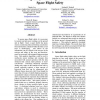Free Online Productivity Tools
i2Speak
i2Symbol
i2OCR
iTex2Img
iWeb2Print
iWeb2Shot
i2Type
iPdf2Split
iPdf2Merge
i2Bopomofo
i2Arabic
i2Style
i2Image
i2PDF
iLatex2Rtf
Sci2ools
ICAI
2004
2004
Using Fuzzy Clustering for Real-time Space Flight Safety
To ensure space flight safety, it is necessary to monitor myriad sensor readings on the ground and in flight. Since a space shuttle has many sensors, monitoring data and drawing conclusions from information contained within the data in real time is challenging. The nature of the information can be critical to the success of the mission and safety of the crew and therefore, must be processed with minimal data-processing time. Data analysis algorithms could be used to synthesize sensor readings and compare data associated with normal operation with the data obtained that contain fault patterns to draw conclusions. Detecting abnormal operation during early stages in the transition from safe to unsafe operation requires a large amount of historical data that can be categorized into different classes (non-risk, risk). Even though the more than 20 years of shuttle flight program has accumulated volumes of historical data, these data don't comprehensively represent all possible fault pa...
| Added | 31 Oct 2010 |
| Updated | 31 Oct 2010 |
| Type | Conference |
| Year | 2004 |
| Where | ICAI |
| Authors | Charles Lee, Darrin M. Hanna, Richard E. Haskell, Richard L. Alena |
Comments (0)

